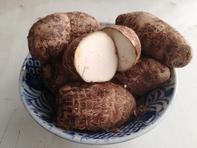The Amadumbe or "potato of the tropics" (Colocasia esculenta) is also known as mufhongwe, madumbis, taro or dasheen but is not related to the ‘real’ potato. Amadumbe has been grown in South-East Asia for over 6 000 years and was introduced to Southern Africa by Portuguese traders in the 1500's as well as Indian indentured labourers later on.

It is a herbaceous, tropical root crop that is grown in South African wetlands and is one of the most important root vegetable food crops in the world. Tannia (Xanthosoma sagittifolium) or elephant ears is another important root crop, widely grown in West African countries and prefered over the amadumbe because of higher yields.
Yet, 90% of the world's commercial production of the amadumbe is from West African countries such as Cameroon, Nigeria and Ghana.
In South Africa, the amadumbe was mostly produced by subsistence farmers in KwaZulu-Natal, Mpumalanga, Western and Eastern Cape provinces, but with the introduction of amadumbe by a well-known retail food chain it has increased the status of this traditional vegetable and staple food.
How to Grow Amadumbes
Amadumbe is a top-shaped tubular root or corm, also called a ‘mammy'. It has a rough brown skin and weighs from 500 to 900 g, but can grow as heavy as 3.6 kg. The flesh is white or pink. Amadumbe prefers semi-shade, but can be grown in full sun if it is irrigated. It needs a warm climate and cannot tolerate freezing.
Amadumbe grows in slightly acidic, moist soil with lots of organic material or compost. It can be propagated from whole tubers or cuttings from tubers. Plant by hand with the cut side down and slightly slanted, about 15 cm deep. Plant amadumbes 60 cm apart with a 1 m space between the rows.
The best planting time is December to April or whenever the soil is moist. Fertilise with NPK (15:15:1). This indicates the ratio of nitrogen (N: 15 units) to phosphorus (P:15 units) to potassium (K: one unit). Sprinkle 5 to 6 Coke bottle capfuls of NPK in a ring about 10 cm around the plant.
Amadumbe is popular with pests such as white ants and rodents and is prone to root rot when planted in waterlogged soils. It is, however, resistance to the mole-rat who prefers crops like potatoes or carrots.
This is because amadumbe is toxic when eaten raw, due to a high level of calcium oxalate crystals, that cause inflammation of the mouth and throat. Harvesting is done after eight to ten months, when the leaves turn yellow.
The roots are dug up with a spade or with a tractor with a special plate. The roots are cleaned, sorted and packed.
A study by Prudence Ntombifikile Tembe conducted in rural KwaZulu-Natal in 2008 showed that retailers prefer a regular supply of small to medium sized amadumbes, cleaned and dried, delivered in crates. The biggest challenge for these rural producers was transporting amadumbes to the markets.
Eating Amadumbes
Amadumbe has a rich earthy flavour, is high in carbohydrates (low GI) and has more protein and amino acids than any other root crop. It has 9% protein compared to potatoes 1.9% and sweet potatoes 1.7%.
It is rich in fibre, magnesium, potassium, iron, vitamin A, vitamin B1, vitamin B2, and vitamin C. It is cooked like potatoes or sweet potatoes and can be boiled, roasted or grilled and served as mash, chips or in stews. Mashed amadumbe is used as a weaning diet.
The leaves, and sometimes the stems, are eaten like spinach and provide a supplement to maize or cooked with coconut cream and served with boiled amadumbe. The Indian community in KwaZulu-Natal has incorporated amadumbe into their diet as ‘puri patta'. The leaves are spread with a spiced batter, rolled, steamed and then sliced and served in pancakes.
Amadumbe flowers (also called ‘aroids’) are processed into flour to prepare ‘fufu', popular with stew in Nigeria. Traditionally Amadumbe is grown as a staple food, but during the past few years, it has been used for other food products. These include an amadumbe and spinach pizza base, crisps, curry and amadumbe flakes.
By Marinda Louw Indigenous Vegetables have sustained rural families over the centuries, adding to nutrients to traditional diets. Unfortunately, over the ye...
Indigenous Vegetables have sustained rural families over the centuries, adding to nutrients to traditional diets. Unfortunately, over the ye... Southafrica.co.za is providing well-researched content in all 11 South Africa languages to allow for all citizens to plant, harvest and enjo...
Southafrica.co.za is providing well-researched content in all 11 South Africa languages to allow for all citizens to plant, harvest and enjo...